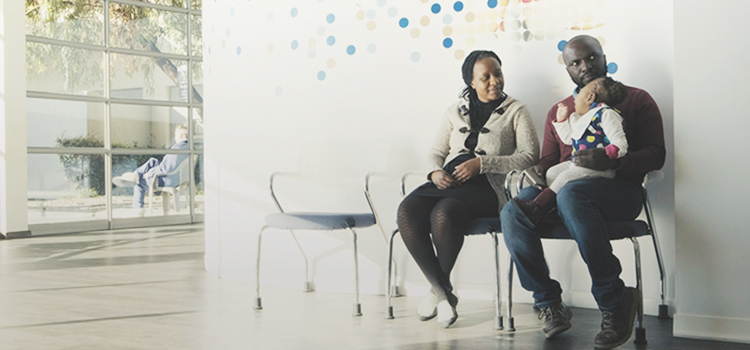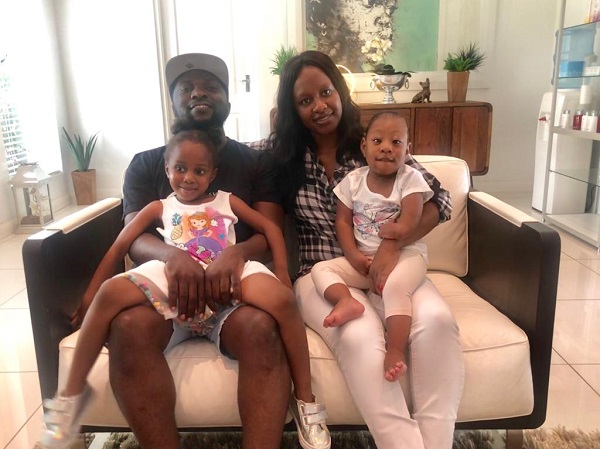Baby Anashe proves she's a fighter - time and again

On 4 May 2017, little Anashe Chakacha was born premature, with the upper part of her skull missing. Doctors held out little hope she would live. She was diagnosed with congenital malformation of the skull and face bones. Now two years old, she’s defied the odds.
In her short life, the little fighter has cheated death three times, first in the neonatal ICU shortly after birth, and then on the operating table where she flatlined twice, only to be resuscitated each time. In two lengthy operations in 2017, a highly specialised surgical team at Life Fourways Hospital in Gauteng drained a water blister that had formed on top of her unprotected brain and then inserted a permanent shunt to drain the fluid into her stomach for elimination.
She pulled through it all, miraculously without any neurological damage and though she continues to have health related challenges, she fights on. Anashe recently turned two years old and she and her four-year-old sister, also named Fadzai, are extremely close. More resilient people than her dad, Fadzai Chakacha, and mom, Lynder Mabuya, you won’t find.
“I blamed myself, I retraced every single thing I ate or did.”
It’s humbling to hear 34-year old mom Lynder, tell of her shock at seeing her new-born infant’s exposed brain and later seeing her tiny malformed arms. It all started with alarmingly early contractions, Lynder was booked off from her financial management job from mid-April 2017 and put on full bed rest.
Anashe arrived prematurely at 36 weeks, via C-section on 4 May 2017.
The only inkling Lynder had of any problem was when her then gynaecologist informed her that a pregnancy scan revealed that her infant had a bit of excess water on her head. “At the time the doctor said it was not a problem, they would just drain the water after birth,” Lynder recalls. “We were never given any indication of the problems with Anashe's arms or anything further around health challenges she may face. We did our routine blood tests, such as those checking for Down syndrome and the results were fine.”
The new-born was tightly swaddled and whisked off to the neonatal ICU, having had no contact with her mother. Lynder recalls the way in which Fadzai was perplexed when allowed to briefly hold his minute-old daughter in the delivery room. “He told me he didn’t know babies were born with their brains exposed,” Lynder recalls. Anashe’s little malformed arms were, at the time, tucked out of sight in the swaddling blankets.
Soon thereafter, the paediatrician told Anashe’s parents they should prepare for Anashe’s death, perhaps within a week, suggesting that if Anashe stopped breathing again they give permission not to resuscitate.
Lynder was shattered. “I blamed myself, I retraced every single thing I ate or did,” she recalls. She asked to see Anashe. In the neo-natal ICU, they gently revealed the open brain and little arms - she was still not allowed to hold her yet. But, the next day she was able to breastfeed Anashe for the first time. To Lynder’s great relief, Anashe latched immediately.
Draining water from Baby Anashe’s brain
What followed was a desperate treatment-seeking effort for the family. Seven days after her birth, Anashe was transferred to the care of a team of five doctors including a paediatrician, neurosurgeon, plastic surgeon and specialist anaesthetist, at the Life Fourways Hospital, via a very slow and careful 30 km ambulance journey, where, upon arrival, an emergency rescue team was waiting for her.
Every member of the Life Fourways treating team visited them within a single hour, securing permission to do whatever it took to give Anashe a fighting chance. Says dad, Fadzai: “Suddenly there was hope. We got to speak to our doctors at least twice a day, getting updates which put us both at ease.”
Within 10 days of admission to neo-natal ICU, Anashe underwent her first five-and-a-half-hour operation. Seeing her emerge, swollen and dripping with tubes, was heart-breaking for her parents, but they were told she’d fought back after briefly flat-lining, as she had after the first surgery to her head, two weeks after she was born. That evening she latched onto Lynder’s breast, again, without hesitation. Several days later Anashe’s brain-surface wound swelled up and the stitches ruptured. It was back into the operating theatre for a two-hour operation to install a temporary external drain.
A third operation followed to insert the drain (also called a shunt) internally, and make it a permanent, flexible fixture. Once again Anashe stopped breathing on the operating table, but was resuscitated. She now had a bio-membrane across the surface of her brain and the scalp stretched across it.
Baby Anashe continues to face challenges
On 11 July 2017, Anashe was finally discharged and came home, nearly two months after she was born. “We cried tears of joy because we never saw that day coming. Our lives revolved around the hospital and our oldest daughter was coming very second,” says Lynder.
Since then the family has been back and forth between hospital and home, first to have bio-membrane stitches removed and later to deal with ongoing health challenges. Anashe’s doctors had planned on starting cranial restoration and arm-correcting surgery but, unfortunately in June 2018 Anashe’s health took a turn for the worse with swelling returning to her brain. Her shunt was replaced but she continued to show signs of illness and this has not corrected in the passing months. “In September we had to have a frank conversation with her doctors about what to do in the event of heart failure or uncontrollable seizure. We had to decide whether or not to resuscitate her or put her onto life support, and made our decisions as best we could,” adds Lynder.
“Currently, there is still swelling on the brain but further surgery is not an option, so we are managing her pain and monitoring her weight, which began dropping recently. Between April and May 2019, Anashe lost almost 2 kg. Doctors believe her brain is not registering or correctly processing the nutrients that she is taking in,” says Lynder. “Anashe eats well but can only have pureed food as she cannot eat solids.” At age two, Anashe is able to sit up, but not talk or walk.

A 2019 family photograph – Dad, Fadzai, holds 4-year-old daughter Fadzai, and mom, Lynder, holds 2-year-old Anashe
Financial support from DHMS key to Anashe’s journey
In early 2019, Lynder was admitted to hospital for a week with stress-related symptoms. It’s no surprise considering the extent to which they have had to face their little girl’s mortality over the past two years. “I have really felt the emotional pressure of it all, but my husband has been my rock, really steadying me and our children through this all. All parents want to give their children their very best, and we have tried to do that for both our daughters. We are mentally, financially and emotionally exhausted. But, we are carrying on,” says Lynder. “My husband has been my counsellor and confidante. When I have cried, he has supported me. And, we both needed to be positive for our children,” she says.
“We would like to thank Discovery Health Medical Scheme (DHMS), for covering most of the bills - especially the hospital bills which have been paid in full. We would also like to thank Anashe’s DHMS Case Manager, who called almost every day just to check in with us when we most needed the scheme’s support,” says Lynder. “We are hoping that, with DHMS’ help we will help us clear most of the doctor’s bills and scans that have been done out-of-hospital as there are still accounts pending. DHMS has been very helpful so far.”
Lynder’s advice to other mothers
“Speak life into your child. Love them, protect them, but most of, all pray for them. If you don’t speak life when they’re suffering, you’re not bringing hope. It’s certainly not easy – it’s really hard. All I want to say is that if you feel like crying, cry. If you feel like screaming, scream, but don’t do it in the presence of your child – you don’t want her to experience that negative energy of giving up,” adds Lynder. “Your child is still your baby, no matter what. Trust God and put God first in everything.”
The Discovery Health Medical Scheme is an independent non-profit entity governed by the Medical Schemes Act, and regulated by the Council for Medical Schemes. It is administered by a separate company, Discovery Health (Pty) Ltd, an authorised financial services provider.
Discovery HomeCare
Discovery HomeCare is a unique homebased service that offers you quality care in the comfort of your own home when recommended by your doctor as an alternative to a hospital stay when appropriate. HomeCare offers minimum disruption to your normal routine and family life. Cover includes postnatal care, end-of-life care, IV infusions (drips) and wound care. These services are paid from the Hospital Benefit, subject to approval. Find out more about Discovery HomeCare here or call 0860 462 273.
Related articles
Baby Simoné receives life saving pacemaker hours after birth
When baby Simoné Scott let out her first cry at birth, her parents’ relief was indescribable. A pacemaker could now be inserted into her body, ending a 10 week wait during which time she could have had a heart attack at any moment, while still inside her mom.
Rare, life-changing drug saves little Matthew May
Without Discovery Health Medical Scheme, (DHMS), covering the estimated R3 million per annum cost of a life-saving drug to keep his ultra-rare degenerative disease at bay, Matthew May, now four-and-a-half years old, would probably not see his teenage years.
Opening hearts everywhere - Chris Truter's story
The Truters make some of Wellington's finest export wines. But their main claim to fame is winning an extended battle to save their son's life. Chris was diagnosed in-utero with Hypoplastic Left heart Syndrome, one of the most challenging of all heart defects.